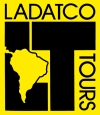

Destinations
Experiences
 |
L A
D A T C O T O U R
S |
 |
||||||||
| HOME | South America | Falkland Islands | Antarctica | Unique Destinations |
Unique Experiences |
Newsstand | ||||
|
Museum
of Paleontology Trelew, Argentina |
|
 |
 |
 |
 |
Review of Museo Paleontológico Egidio Feruglio (Paleontological Museum Egidio Feruglio)
Compliments of www.FROMMERS.comThe MEF, as it is widely known, is one of the best paleontological museums in South America, a must for dinosaur fans. Opened in 2000, it houses an amazing collection of fossils and dinosaur bones. Inside the museum (and visible when you visit) is a working lab where a team of scientists studies and cleans fossils. Try to come here during the week when the scientists are at work (Mon-Fri), and you'll get a sense of how much they do to study just one fossil. An amazing skeleton of a titonausaur, which walked on this land 70 million years ago, fills one room. Other rooms take you through a chronological order of dinosaur discoveries over the years, from past to present. There's also a good movie with English subtitles showing sea fossils found in Patagonia. You'll need about 1 1/2 hours to visit the museum. The lobby houses a gift shop and a snack bar.
Museum of Paleontology Egidio Feruglio
From Wikipedia, the free encyclopediaThe Museum of Paleontology Egidio Feruglio (MEF, in Spanish: Museo Paleontológico Egidio Feruglio) is a science research and exhibition center in Trelew city, Patagonia (Argentina). Its permanent and travelling exhibitions focus on the fossils remains from fauna and flora of Patagonia, as well as the geological changes that affected the region throughout prehistory. The museum is named for Egidio Feruglio, an Italian-born geologist who spent most of his career in Argentin
MEF is also one of Argentina's main scientific institutions, with a robust research program in areas such as Vertebrate and Invertebrate Paleontology, Paleobotany, and Ichnology. It also has a group focusing on plants in semi-desert environments.
MEF exhibitions
MEF's permanent exhibition is a journey into the natural past of Patagonia. It begins about 10,000 years ago, with the first human settlements in the area. In each room, specimens from both terrestrial and marine life forms are shown for each geological period, up to the early Paleozoic. The Mesozoic hall depicting the giant dinosaurs of Patagonia is perhaps the most popular attraction in the museum. The journey goes on at the mini-theatre with a film showing the evolution of the Universe back to the Big Bang itself.The exhibition also offers a view into MEF's largest, state-of-the-art Preparation Laboratory, where fossils are carefully cleaned and separated from its surrounding rock. Visitors can here witness the progress of actual work done on the most recent fossils findings.
Also, shown daily at the "Germán Sopeña" Auditórium is The Mystery of the Jurassic, a BBC production featuring MEF scientists.
The traveling exhibition featuring the "Dinosaurs of Patagonia" has visited many cities in Argentina and abroad. A recent European tour included Germany, Spain, Portugal, and the Czech Republic. Individual replicates have been provided to museums in different countries.
Bryn Gwyn Geopark
MEF also administers the Bryn Gwyn Geopark, a large natural geological reserve located 5 miles South of Gaiman, and about 17 miles from Trelew. The park is located on the slanted lands that separate the Chubut River valley from the higher Pataognian steppe. The trail depicts typical fossils (both real and replicates) dating up to 40 million years ago.Research
MEF is an "Associated Research Unit" to Argentina's National Research Council (CONICET), a qualification attained by very few local NGOs. Almost all of MEF researchers and postdoctoral fellows are career scientists working under CONICET.The Museum's research area includes a Collection with more than 17,000 fossils (as of 2009), preparation laboratory and campaign equipment. It also has a workshop for fossil replicate production, used both in research and exhibitions.